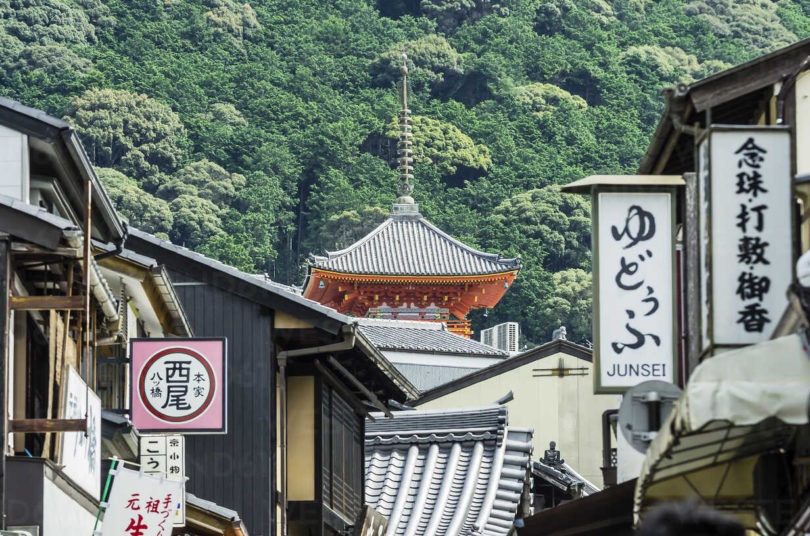City center Gion, Kyoto’s most popular entertainment and cultural district, is here. During the day, Michael Lambe takes us on a tour of Gion’s most notable landmarks, shops, and historic sites.
Gion
From the Kamo-gawa River to the Yasaka-Jinja Shrine, Gion is a historic entertainment district situated north and south of Shijo Street. With so many pilgrims flocking to Gion Shrine, it expanded its entertainment district.
Because of kabuki’s success, Kyoto’s most renowned geisha district was formed, and today Gion is a major tourist destination. During the evenings, lanterns are lit, and trainee geisha scurry through the narrow lanes of Gion to their appointments, a lively neighborhood full of bars, restaurants, and traditional teahouses. However, there is a lot to see during the day at this location. So let us go on a walk around Gion and see the shrines, temples, and other historic sites.
The Minamiza Kabuki Theater in Tokyo, Japan
Shijo-Dori Street leads us eastward from Gion-Shijo Station. Shijo’s southeast corner is the magnificent Minamiza theater near a well-known noodle shop.
Japanese kabuki performances are a big draw in the Minamiza. In Kyoto in the early 17th century, the Minamiza was one of seven such theaters. Other than that, the Minamiza may still be home to kabuki performances. If there is no performance today, please go to the ticket office and get a flyer. Take a look at the stunning facade and dramatic gabled roof. A theater is said to have been at this location as far back as the early 1600s.
Meyami Jizo
Chugen-ji, a little temple on our right, is easy to overlook as we proceed east. The Jizo deity within Meyami Jizo Temple gave the temple its name.
Japanese Buddhist bodhisattva Jizo is shown at temples and roadside shrines. In addition to being a revered faith healer, Chugen-ji Temple’s Jizo is a well-known superhero.
In 1228, the Kamo-gawa River was said to have broken its banks, putting the lives and livelihoods of many people in danger. It is reported that Jizo physically saved individuals from rising seas after praying to the Jizo for assistance. “Ameyami Jizo” was the name given to the teller of this tale (Rain stopping Jizo). As a result of the statue’s remarkable ability to heal the eyes, it was later dubbed “Meyami” or “Eye-curing” Jizo.
Hanami-koji
Hanami-koji, or “flower viewing path,” crosses Shijo a few blocks east of Chugen-ji Temple. The main thoroughfare of Gion. Traditional teahouses are known as chaya line, a flagstone-paved walking path to the south of Shijo, which is well-preserved. On the southeast corner of Shijo and Hanami-koji, Ichiriki Chaya is a large red teahouse.
One of Tokyo’s oldest restaurants, Ichiriki Chaya, has long been a favorite of high-ranking business and political leaders invited to dine there. One of the best-known teahouses in the world. Samurai warriors plotted the downfall of the shogun here (see my article Kyoto Samurai). Renowned samurai retribution also took place in the Ichiriki teahouse.
The Tale of the 47 Ronin
Literature, kabuki theater, fine art, and cinema have all depicted the story of the 47 ronin. Indeed, this legendary story of loyalty and deception is real. In Edo Castle, Kira Yoshinaka and Asano Naganori had a personality conflict in 1701. When Asano Yoshinaka lost his mind, he pulled his sword and attempted to murder him. Asanori was ordered to commit ritual suicide (seppuku) after failing in his attempt to defy the rules (and thereby literally lost his head). Retribution for Kira’s death was promised by Asano’s disciples, now “ronin,” or masterless samurai, who pledged to do so.
After that, the ronin went out and sought new employment. The monks and traders were all born in the same place. Upon moving to Kyoto, Oishi Kuranosuke, their commander, began frequenting Ichiriki. Gambling and women appeared to be the order of the day for him in this town. But it turned out to be a cunning ruse!
Two years to wake up and persuade his enemies that Oishi had no malice. They regrouped here, and after killing Kira, they buried his body near Asano’s grave. The 47 ronin committed ritual suicide after breaching a strict government regulation barring vendettas, but their fame grew with each telling their tale.
Gion Corner
Gion Corner, or the Gion Kobu Kaburenjo theater, is the next stop on the Hanami-southbound koji’s route.
The district’s geisha conduct the famed Miyako Odori dance between April and October. In addition, an hour-long cultural feast with a tea ceremony, flower arrangement, geisha dancing, and traditional Japanese music is available year-round.
Yasui Kompira-gu Shrine
A stone tool shrine gate can be seen on our right at the end of Hanami-koji, Yasui Kompira-gu Shrine.
It is said that the “power stone” in the middle of this shrine may help individuals form strong bonds with one another. After you have prayed in the main cathedral, write your request on a special piece of paper (purchased at the shrine). Go twice around the stone with your wish in mind (and in your hands). Afterward, attach your request to the stone. There are long lines of singles hoping to find a date with the stone on the weekends. In addition, the stone may aid in the cessation of bad behaviors like smoking and drinking.
Kennin-ji Temple
Returning to the southern end of Hanami-koji, let us go there. First, to enter the temple complex of Kennin-vast ji. One of Kyoto’s oldest Zen temples, erected in 1202. Because of the many fires that have destroyed the original buildings, the ones that remain are just 250 years old. The main temple complex is now open to the public, but the smaller sub-temples (Hojo and Hatto) are still closed to the general population.
Kennin-ji was erected by Myan Eisai, a renowned Buddhist monk. Zen Buddhism and tea were brought back to Japan by Eisai in the 12th century after he made two travels to China. Because he thought tea would help his monks remain awake throughout long periods of zazen meditation, Eisai was eager to spread the word about the health benefits of tea. Tea plant hedges surround Kennin-ji as a consequence. A stone plaque honors Eisai’s tea importation in the temple’s southeast corner.
We will pay our 500 yen admission fee at the reception building and then visit the Hojo building after exploring the temple grounds.
A famous screen painting by Tawaraya Status depicts the thunder and lightning gods. An original photograph has been reproduced here at the National Museum of Kyoto. So let us go for a walk in the woods and see the stone gardens of Kenning-rippling ji.
Why not relax on one of the wooden decks and unwind for a while?
There are two entrances to the Hatto building from the Hojo’s southern side. A wonderful picture by Koizumi Junsaku hangs in this structure. It was commissioned for the 800th anniversary of Kenninji in 2002. A dragon (a symbol of knowledge) often emerges from a circle in Zen temples (which represents the universe). Two immortal dragons creeping across the ceiling are shown in Koizumi’s artwork.
The Shrine of Ebisu-jinja
At Yamato-Oji Street, we exit Kennin-ji on the west side. Our destination is Ebisu’s shrine, the goddess of good fortune and prosperity, so let us proceed south.
Kennin-ji Buddhist temple is only a few blocks away from Ebisu Shrine, a Shinto shrine. A violent storm tore through Eisai’s ship as he tried to make his way back from China, the inspiration for Kenninji. Eisai prayed to the seafarer’s protective god Ebisu when he was afraid the ship might sink, and the storm eventually passed. To express his gratitude to Ebisu for securing his safe return to Japan, Eisai built Kennin-ji. In Japan, religious beliefs like Shinto and Buddhism are not regarded as incompatible; hence Eisai’s decision to do so may appear strange to others.
Café Opal
We may discover Café Opal on our right immediately before the exit from Kennin-ji as we return north. This “world’s most soulful cafe” is the perfect location to unwind after an exhausting day of exploring.
The owners of Café Opal remodeled and renovated an 80-year-old historic wood townhouse in a vibrant and youthful color scheme. This is a great place to relax, thanks to the large speakers playing jazz and the fact that there is no smoking everywhere except in the little garden. The food is tasty, but it is also pricey, so that we will stick to the drinks. Check out the cafe’s website for more details.
Gion Antiques and Crafts
Take Yamato-Oji Street north and cross Shijo. North of Shijo, Yamato-Oji becomes Nawate-Dori Street. Shinmonzen and Furumonzen, two of Gion’s most important traditional artisan and antique shops, are located here (two streets off Nawate to the east). In addition, shops offering fabrics, scrolls, prints, and furniture may be found in this neighborhood. The same family has owned many businesses for many years now.
Shimbashi
Flowing east to west from Shinmonzen, Shimbashi-dori Street is regarded as one of Gion’s most attractive streets. The Shirakawa canal runs through the middle of this path, bordered by historic buildings and willow trees. It is a beautiful place to take a walk or a late-night promenade, even in the winter.
There is a poem by Isamu Yoshii carved onto a stone beside the canal. In its previous location, a tea house had been built over the canal so that visitors could hear the water below. Now, the monument stands in its place. Geisha pay their respects to Isamu Yoshii on November 8th each year by placing flowers near the stone.
Gion Sweets
No trip to Gion is not complete without trying the city’s world-famous confections. Patisserie Gion Sakai is once again located on Hanami-koji. Because the wood is fresh, this business is simple to find only a few blocks south of Shijo on the west side of Hanami-koji.
Inside, you will find baked goods, including cakes, tarts, meringues, etc. Whiskey chocolate biscuits are extremely delicious.
Tsujiri is the most well-known sweet shop in Gion, though.
Between Hanami-koji and Yamato-Oji, Shijo is home to this matcha tea and dessert shop. You may have matcha tea parfaits or pastries on the second level. Because of this, there is always a line that extends halfway down the street. Instead, go down to the ground level and have some ice cream. We could go back to Kawabata Street and have ice cream on the riverbank.
Gion at Night
We might have seen a lot of Gion during the day, but it is like an otherworld at night. Maiko, or apprentice geisha, race to their appointments in the repaired streets while the streetlights illuminate teahouses. Chris Rowthorn Tours can organize a private evening walk in the Gion district of Kyoto.

